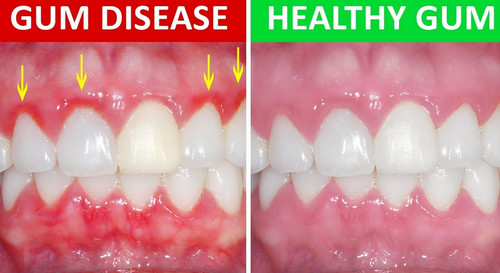Tips to Cure Gum Disease
GUM DISEASE
Gum disease, also known as periodontal disease, is a set of inflammatory conditions affecting the tissues surrounding the teeth. This affection is the leading cause of tooth loss.
WHAT IS THE MAIN CAUSE OF GUM DISEASE?
In most cases, the development of gum disease starts with plaque which is a biofilm or mass composed mainly of bacteria that grows on surfaces within the oral cavity.
- Insufficient oral hygiene: Brushing and flossing help get rid of plaque. Dental plaque that is not removed can harden and form “calculus” that brushing doesn’t clean. This causes gum inflammation which will eventually transform into gum disease if not treated on time.
If left untreated, gum disease will eventually develop pockets between gums and teeth that will be filled with bacteria, plaque and calculus. In time, these pockets become deeper, and these deep infections cause a loss of tissue and bone.
There are several risk factors for gum disease:
- Smoking
- Diabetes
- Hormonal changes
- Teeth grinding
- Certain illnesses that cause decreased immunity, such as HIV/AIDS, leukemia, and cancer treatment.
- Obesity
- Genetics
- Certain medications that cause dry mouth or gum changes.
WHAT ARE THE SIGNS AND SYMPTOMS OF GUM DISEASE?
- Permanent bad breath
- Red and swollen gums
- Tender or bleeding gums
- Tooth sensitivity
- Receding bone and gums, making your teeth look longer than normal
- Loose teeth
- Pocket formation between gum and teeth (pus may be present)
- New spaces developing between your teeth
WHAT COMPLICATIONS CAN GUM DISEASE CAUSE?
The bacteria responsible for gum disease can enter your bloodstream through gum tissue, and may affect other parts of your body, including respiratory problems, stroke and coronary artery disease. Also, if it is present during pregnancy there is a higher risk of preterm birth and preeclampsia.
HOW TO PREVENT GUM DISEASE?
- Good oral hygiene
- Brushing your teeth at least twice a day.
- Flossing regularly to remove plaque from between teeth.
- Use mouthwash three times a day after each meal. Ingredients of antimicrobial agents vary but can include; chlorhexidine 0.05%, chlorine dioxide, and zinc chloride.
- Dental visits: Visit your dentist or dental hygienist regularly twice a year. If you have risk factors that increase your chances of developing gum disease, you may need professional examinations more often.
- Avoid tobacco
- Use a night splint if teeth grinding is a risk factor.
WHAT TREATMENTS ARE AVAILABLE FOR GUM DISEASE?
Your dentist will provide a good diagnosis and a treatment plan that is adequate for your case in particular.
- Deep cleaning:The first line of treatment for gum disease is a careful, in-depth cleaning. The dentist can do additional procedures of deep scaling and root planning. That is when the rough surfaces of the roots of your teeth are smoothed out, helping the gums reattach to tooth.
- Medication: Your dentist may prescribe medication as part of your treatment and also the use of a medicated mouth wash for oral hygiene at home.
Other treatments
- Surgical treatment (Flap surgery): To gain access to all the tooth surfaces for a more thorough cleaning.
- Guided tissue and bone regeneration: A surgical procedure that provides bone and gingival tissue growth at sites that have insufficient volume or dimension.
- Laser therapy: The gum pockets are treated with a soft-tissue laser to eliminate bacteria, remove damaged tissue and help stimulate healing.

